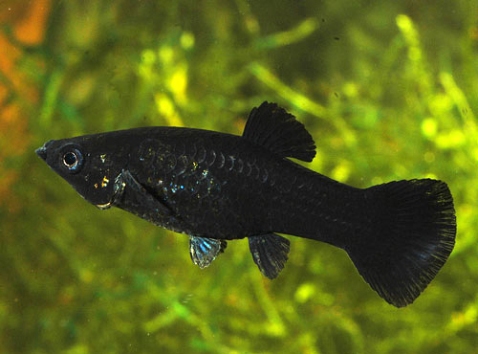Black molly (Poecilia sphenops)
Short finned molly (common name)
Poecilia sphenops (fish name)
Maximum size in aquariums (min-max): 12 – 15 cm ( 4.72 – 5.91 in )
pH of water: 7 – 8.5
Water hardness (dGH): 12 – 18 °N
Recommended temperature: 21 – 26 °C ( 69.8 – 78.8 °F )
Compatibility (temperament to it’s family): peaceful (read this answer)
Compatibility (temperament to other fish species): peaceful (read this answer)
Place in the aquarium: Top levels
The way of breeding: Pseudo-Livebearer
Fish origin: Central AmericaFeeding
Vegetables, granules, sometimes worms.Sexing
Females are larger.Breeding
Quite easy. You just need a male along female. These fish breed easy such as Guppies.Lifespan
3 years.Additional information
Also known as Black molly, Black mollie, Molly.

The black molly, also known as the midnight molly, is a hybrid species between Poecilia latipina and Poecilia sphenops. This live bearer is named for its very dark, all over black coloration. At times this fish can be found with a yellow streak on the dorsal fin or minor silvering on the flanks, but for the most part this fish lives up to its common name: black molly. The black pigmentation of this fish is a result of a melanistic condition. Melanism, the opposite of albinism; it is a condition in which the full potential of melanin or skin pigment is represented. The result is a really dark black pigment which is the opposite condition of albinism; the lack of color pigmentation.
This strain of molly is not one that occurs naturally in the wild. The black molly is bred to display certain desirable traits in the aquarium industry. The lyretail black balloon molly is one hybrid commonly sold for its fine display of unique finnage and its cute, puffy physique. But not all black mollies are born with fancy fins or the balloon shaped bodies, and many times they are not completely black. It just depends on the combinations of dominant and recessive genes and just plain luck. Some aquarists do not see these traits as a good thing because of the consequences that come with the mutated varieties. The balloon characteristic is a type of deformity that happens to be coveted in the aquarium industry. But along with all the desirable traits come the unforeseen weakness of shorter life expectancy and susceptibility to disease. Because of all the selective breeding these fish are not as hearty as the wild-type specimens they were hybridized from.
In general, mollies are native to areas of North and Central America along coastal salt, brackish and fresh water regions. This goes for the “wild-type” mollies, not the industry bred variations including the black molly. Wild mollies reside in the shallow surface waters of ponds, marshes, streams, swamps and estuaries. Populations were transported to New Zealand, Western United States and Hawaii because they are so highly adaptable. With the ability to live in salt and freshwater, this thriving species is an easy one to start with for new aquarium hobbyists.
The black molly is a great species to have in a peaceful aquatic community because of its ease of compatibility with like temperaments. They thrive in at least 30 gallons of clean water with a neutral to slightly alkaline pH between 68-82ºF. In a well planted tank, this species will readily reproduce if kept with 4 females for every 1 male. The males have a tendency to want to mate constantly so having a 1:1 ratio of male to female will cause the female to be exhausted and her health will most certainly falter.
The sexing of mollies are fairly easy as it is with most live bearers. Internal fertilization is possible by the gonopodium on the males. The gonopodium is a modified anal fin that is used to inseminate females in the mating process. The mating ritual takes place as the male displays his fins to impress the female. The females of this species are able to become pregnant again and again after just mating once. She has the ability to store sperm in her body so that she can become pregnant in a matter of weeks after giving birth. Mollies can give birth to as many 60 babies every 2.5 months.
Once a female is pregnant it is important to separate her from the male. The reason for this is he will want to keep mating with her even in her fragile state and she does not need the added stress. The gestation period of a molly is about 4 weeks, the key is to not move her too quickly after getting pregnant or she will abort the pregnancy due to too much stress. Do not wait too long before removing her to a well-planted birthing tank because she may miscarry if she is too far in her pregnancy and the stress levels reach too high for her to handle.
Once the babies are born they will seek refuge in the plants. Mollies are not very good parents and will see their babies as food once they are born. Remove the mother and look after the fry separately. They will need a well rounded diet in order to develop properly. A diet of crushed flake food can is an okay diet but feeding the fry newly hatched brine shrimp and microworms will greatly promote better development. Feed them as often as 3-4 times a day for the first few weeks to ensure they get enough to eat. Perform partial water changes every other day to keep the water from clouding due to the more frequent feedings.
Be sure to separate the males from the females as soon as you can tell them apart because you do not want them mating with one another. Inbreeding can result in deformed or sterile fry and the only way to prevent that from happening is to keep males and females in separate tanks. To perpetuate the community you may want to go to an aquatic retailer that you haven’t bought mollies from in the past. There is no guarantee that they will not be related to your mollies but the odds are better this way.
SURSA: www.aqua-fish.net

Ultimele comentarii